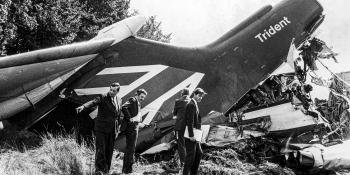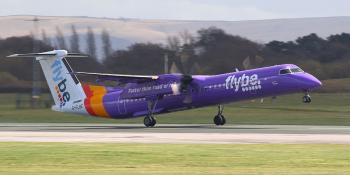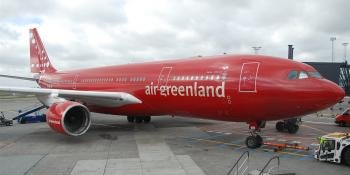On the 100th anniversary of de Havilland, Key Aero examines the history of the DH.121 – later the Hawker Siddeley HS-121 Trident – which was the Hatfield-based airframer’s final airliner design before its merger in 1960
The Trident claimed several world firsts, most notably it was the first T-tail rear-engined trijet airliner ever to be designed and was also the maiden commercial aircraft to make a blind landing during a revenue service in 1965.

These claims to fame, unfortunately, didn’t translate to commercial success because a combination of bureaucracy and design changes led the type to be late to market which stunted its appeal to customers, who by then already had the competing Boeing 727 in their sights.
Alistair Hodgson, the curator of the de Havilland Aircraft Museum details the type's history in the video below.
By the end of the programme in 1978, only 117 Tridents had been produced, although several remained in service until the 1990s when they were removed altogether.
De Havilland Design
In 1953 – following the introduction of the world’s first turboprop airliner the Vickers Viscount – British European Airways (BEA) was already looking for a replacement for the type. While several airlines were investing in pure jet-powered fleets, BEA chose to favour the turboprop powerplant based on its superior economics.

The British carrier subsequently ordered an enlarged version of the Viscount – called the Vanguard – in July 1956. However, by this point, the French-built Sud Aviation Caravelle had conducted its first flight and BEA began to recognise that jet aircraft could soon provide stiff competition for its propeller-driven examples.
The carrier conceded that a small number of jets could be used to supplement its turboprop fleet. The same month, BEA issued outline requirements for a short-haul jetliner that could carry a payload of 9,100kg or 70 passengers, up to 1,000 miles. The aircraft should also be able to cruise at around 620mph and have more than two engines.

Four companies prepared projects to match the BEA requirements including Bristol, Avro, Vickers and de Havilland. The latter considered three possible contenders for the specification – two of which were four-engine developments of the early Comet. In July the following year, the firm made another submission in the form of the DH.121 – which largely resembled the eventual production aircraft.
By August 1957, the plan had been revised to include the in-development Rolls-Royce Medway turbofan engine – in place of the Avon turbojet – and an expansion to accommodate up to 98 passengers.

From the outset the DH.121 was planned to feature advanced avionics for the period. Among other capabilities, it would be able to conduct and automatic approach and landing within a few years of service entry. The systems were also triplicated to offer maximum redundancy during these procedures.
The design was revised for a third time following concerns by BEA of a decline in passenger growth in March 1959. They concluded that the range and capacity of the DH.121 was too great for their needs and asked de Havilland to reduce the scale of the design to suit their projections.

Downsizing the type involved substantial changes to the model being made, including powerplant adjustments from the Medway to a smaller derivative, the 40% less powerful Rolls-Royce Spey 505. The range was also cut by more than half to 930 miles and capacity by about a quarter to 75 or 80 seats.

Eventually, de Havilland and BEA came to an agreement and the carrier ordered 24 examples with 12 options on August 24, 1959. The revised design was announced to the public in early 1960 and the future airliner’s name, Trident, was unveiled at the Farnborough Airshow that year.
Changing Hands
Hawker Siddeley, which had merged with de Havilland in 1960, wanted additional customers for the type, so entered discussions with American Airlines. The carrier requested a longer-range variant, a role the original design would have been perfectly suited for. In response, work began on the Trident 1A which was to be powered by the uprated Spey 510 engines and feature larger wings and fuel tanks. American eventually decided against the Trident, instead opting for the American-built Boeing 727.

Some of these modifications were added into the original prototype, named the Trident 1C, with the main difference being the larger fuel tank in the centre wing section that raised the range to 1,400 miles.
The first example, G-ARPA (c/n 2101) made its maiden flight on January 9, 1962 at Hatfield Aerodrome, and entered service on April 1, 1964. By the following year, there were 15 jets in BEA’s fleet and by March 1966, its roster had grown to 21.

The beginning of the end for the type came in the early 1980s when the International Civil Aviation Organization (ICAO) began drafting noise regulations that would require operators of first- and second-generation jetliners to fit hush kits to their fleets’ engines.
British Airways, the type’s largest operator concluded that the required retrofits were not viable and instead chose to phase the Trident out of its fleet in 1985. The jet’s services in China ended in 1995, marking its permanent retirement from service.

The decision to change the design from the original plan certainly hampered the type’s ability to succeed in competition with the larger Boeing 727 – of which 1,832 were built and continued in passenger service until last year with VIP examples still in use.
Despite this, the Trident will always be the final de Havilland airliner design, marking the end of an era for the pioneering aviation brand.





